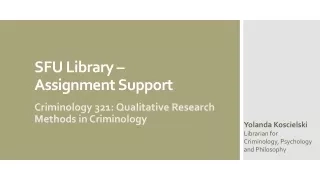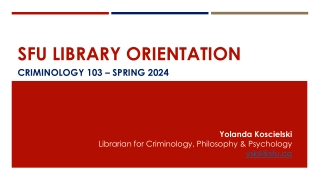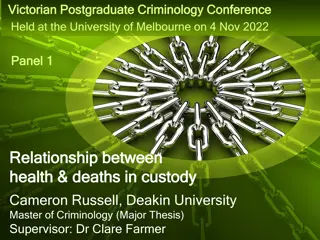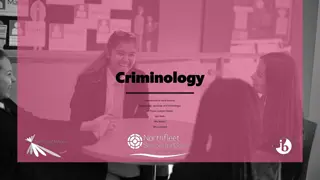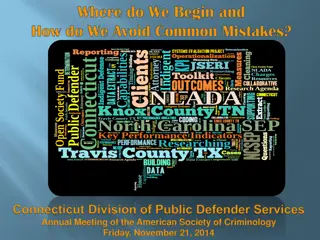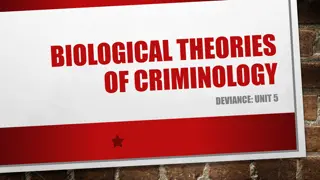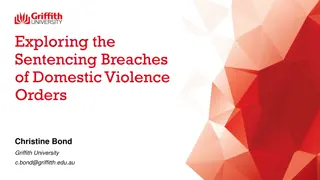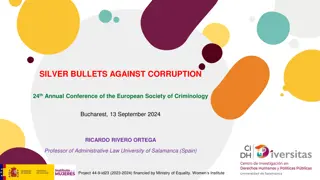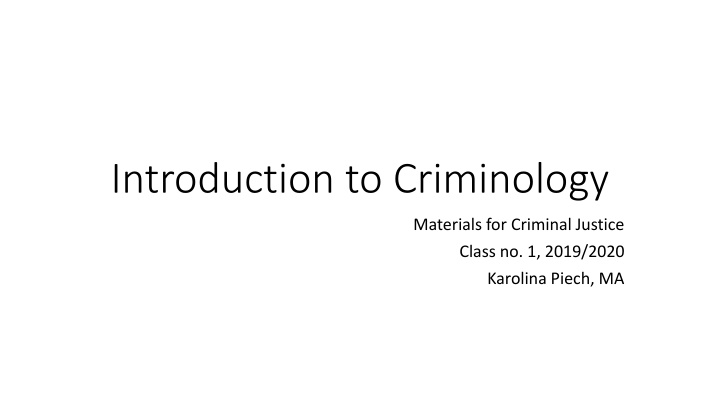
Exploring the Foundations of Criminology: An Overview
Delve into the realms of criminology with insights on its definition, interdisciplinary nature, and historical origins. Discover the diverse fields and key figures shaping this intriguing discipline.
Download Presentation

Please find below an Image/Link to download the presentation.
The content on the website is provided AS IS for your information and personal use only. It may not be sold, licensed, or shared on other websites without obtaining consent from the author. If you encounter any issues during the download, it is possible that the publisher has removed the file from their server.
You are allowed to download the files provided on this website for personal or commercial use, subject to the condition that they are used lawfully. All files are the property of their respective owners.
The content on the website is provided AS IS for your information and personal use only. It may not be sold, licensed, or shared on other websites without obtaining consent from the author.
E N D
Presentation Transcript
Introduction to Criminology Materials for Criminal Justice Class no. 1, 2019/2020 Karolina Piech, MA
Definition of the criminology Science about crime Social science dealing with researching and collecting comprehensive knowledge about crime, crime, perpetrator, victim, as well as about institutions and mechanisms for preventing and combating crime Science about crime and the offender, about the symptoms and causes of crime and other related phenomena of social pathology and methods of their elimination
Definition of the criminology Social science dealing with researching and gathering comprehensive knowledge about crime as a specific form of deviant behavior, crime as a certain social phenomenon, as well as the perpetrator of the crime, as well as victims of crime, as well as the institutions and control mechanisms that create societies to prevent and fight crime
Criminology as an interdisciplinary science Criminology and medical sciences Criminology and biological sciences Criminology and psychology Criminology and psychiatry Criminology and pedagogy Criminology and statistics Criminology and sociology Criminology and economics
Criminology and other penal sciences Criminology and substantive criminal law Criminology and procedural criminal law Criminology and forensics
Fields of criminology Victimology Criminal etiology Phenomenology Suicidology
The beginnings of criminology C. Lombroso P. Topinard The end of the 19th century In their scientific work they focused on crime as a phenomenon that was then in the circle of anthropological sciences
Anthropological direction Mendel's concept of inheritance Theory of teleogony - extermination of uncomfortable people, e.g. German women, who had intercourse with men of other races during the Second World War Lang's research on twins
Sociological direction The theory of anomy, whose creator was Emil Durkheim; the offense is treated as a social fact or phenomenon; Theory of Diverse Relationships - Edwin Shuterland -> Everyone shapes their personality based on the behavior of other people.
The concept of new criminology Professor Falandysz Crime as a ruling class decision False law Marxist concept
Main areas of research crime as one of the social categories, crime as a social phenomenon, criminal, victim of crime social control institutions and social reaction.
Interesting facts The term criminology first appeared in 1879 and was used in the work of the French anthropologist Paul Topinard. Some scientists consider the doctor Giambattiste della Porta to be the first criminologist. The first criminology textbook (under this title) was published in 1885 by the Italian lawyer R. Galofalo.

